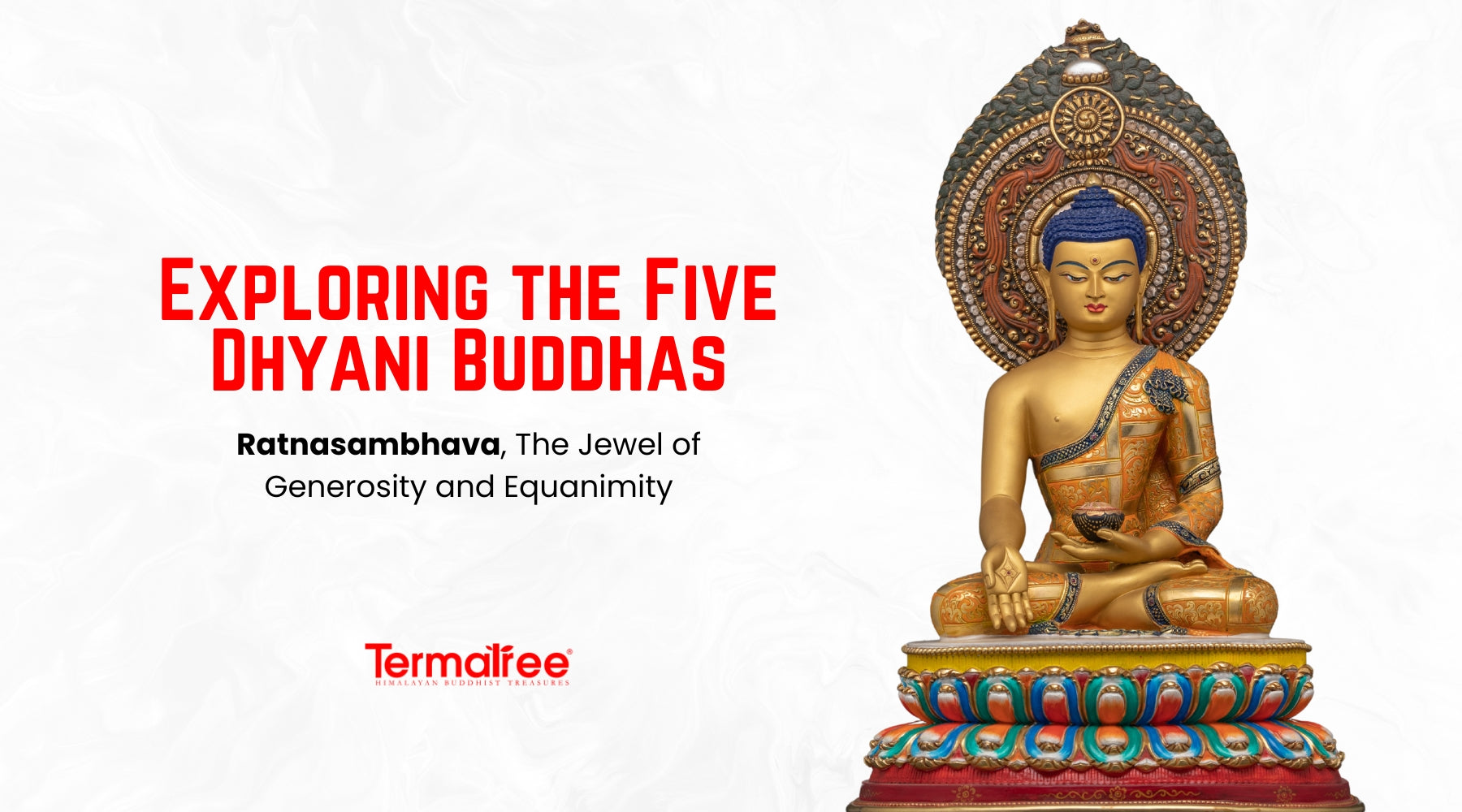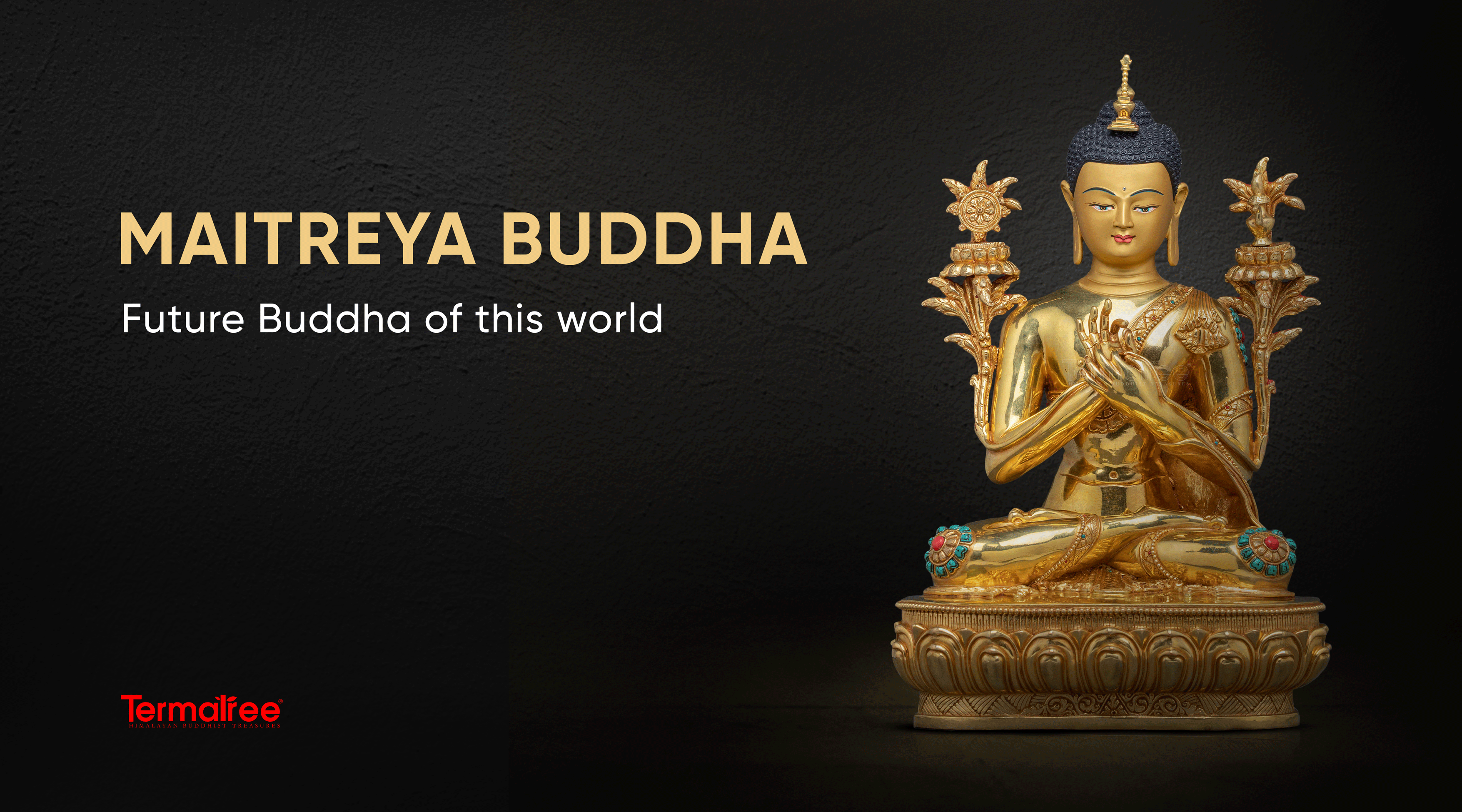Radiance of Generosity: Ratnasambhava, the Jewel-Born Buddha
Among the Five Dhyani Buddhas, Ratnasambhava has a grounding and illuminating quality, and while it may not be emphasized as much as in the other aspects, he is nonetheless a Buddha deeply revered by practitioners who wish to go beyond pride, fear, and achieve equality. Ratnasambhava means “Jewel-born”, which refers to his iconography associated with wealth and abundance, as well as the wisdom that refracts off of ego to reach compassion. He resides in the southern direction of the tantric mandala, and expresses golden light signifying generosity, which changes spiritual pride to profound awareness of equanimity.
In the practice of Vajrayana Buddhism, the essence of this dhyani buddha is called upon through visualization, mantra, and contemplation, and is primarily geared to transmute one's own inner arrogance or subtle forms of superiority, which separate us from others. His energy is relative to Earth based on its element and the season of spring, which is about growth, fertility, and grounded abundance - characteristics of what it is to blossom, innate wisdom in all beings. Given its warm embrace, Ratnasambhava is calling us to return to what we share in common as beings and imploring all practitioners to share their generosity, openness, and appreciation.
Tracing the Origins of Ratnasambhava

The earliest reference to Ratnasambhava can be found in the 4th century CE works, Suvarṇaprabhāsa Sūtra and the Guhyasamāja Tantra. More elaborate descriptions of him are seen in the Advayavajrasaṃgraha, which emphasizes his importance as a powerful transformative aspect of the Buddhist pantheon.
In the Chinese Buddhist text, the Śūraṅgama Mantra, he is the leader of the Jewel-Creating Division of the South and is associated with heavenly forces capable of transmuting negativity into positive energy or potency. Jewels are associated with the spiritual wealth of wisdom and compassion. There is a recognition of Ratnasambhava as a guiding Buddha who helps sentient beings toward liberation in the Kṣitigarbha Bodhisattva Pūrvapraṇidhāna Sūtra. In the totality of these texts, it is evident that he is significant in his respective Buddhist tradition.
In all of these texts, Ratnasambhava transcended a mandalic figure; he has a rich biological weave in the cosmology of Buddhism, he is a jewel-born Buddha whose spiritual generosity and wisdom of equality are close to how to awaken.
The Meaning of the Name "Ratnasambhava"
Derived from Sanskrit, the name Ratnasambhava translates to "jewel-born" or "born of a jewel" — "ratna" meaning jewel and "sambhava" meaning the origin or point of origin.
This name suggests he is the embodiment of spiritual affluence, generosity, and inner dignity, for our world's wealth appears only in the possession of possessions to many people. For others, wealth comes partly from their own, but the uncertainty of meaning, purpose, and understanding anchors inner dignity.
As a jewel, the wisdom of this dhyani buddha is rare, shining, and precious, reminding practitioners that "true wealth" is not found in material gain, but through awakening the abundant qualities of the enlightened mind.
Iconography of Ratnasambhava

1. Body Color and Symbolism
Ratnasambhava is nearly always represented in a rich golden-yellow color, which signifies both internal wealth and expansive generosity. Yellow is associated with earth and growth, suggesting that Ratnasambhava's wisdom is both stabilizing and nurturing. He embodies abundance — not just in terms of material wealth, but also the inner wealth of humility, dignity, and balanced self-esteem.
Furthermore, this vibrant color is related to the transmutation of pride. While pride usually creates a separation — a sense of being in a position above everyone else — Ratnasambhava's golden light dissolves such false dominion by understanding that everyone, without exception, possesses equal Buddha-nature. In the presence of this Buddha, the pride that was once ours becomes the seed of wisdom, the awareness that every sentient being is equally capable of awakening.
2. Mudra (Hand Gesture)
Ratnasambhava is commonly recognized by the Varada Mudra, the gesture of enormous generosity. His right hand is extended downwards, with an outstretched and open palm which often rests lightly on his knee, suggesting that the viewer take it. In depicting this mudra, he conveys an open-hearted willingness to give freely and without hesitation, exemplifying the Bodhisattva ideal of giving with no expectation of return.
While generously giving is a practice in itself, this mudra is significant in many ways, roughly tracing the line towards letting go. When we give freely, whether it be things, teachings, or time, we let go of attachment a little more easily. His Varada Mudra reminds the practitioner that true wealth is having the ability to share; the ability to generously give is the path to Enlightenment.
3. Symbol: The Jewel
The sacred symbol of Ratnasambhava is naturally a jewel, or Ratna. This identifies not only material wealth but also spiritual wealth. In many thangka paintings and Buddhist tantric visualizations, we find him depicted holding the cintamani or the wish-fulfilling jewel, a mythical jewel that is said to fulfill every spiritual wish.
In the Buddhist view, the jewel serves as an important metaphor. It holds a representation of all beings' potential to recover the brilliant, indestructible wisdom that is buried under ignorance and ego, like a jewel buried under years of dirt and grime. Ratnasambhava's jewel is also a reminder of the Three Jewels, or followers of the Buddha, for when we consider our ultimate refuges in practice — Buddha, Dharma, Sangha — we are reminded that Ratnasambhava tells us that the most precious resources we have are not external wealth, but something deeper within us.
4. Mount and Throne
Ratnasambhava is usually shown sitting on a lion throne, which represents fearlessness, majesty, and the power of Dharma. The lion stands for the noble and powerful aspect of human nature that exists within Ratnasambhava's ability to remove the inner arrogance that causes us to fall into delusion. Just as the lion's roar commands silence in the jungle, the wisdom of Ratnasambhava commands silence to pride and judgment.
His lion throne and images of the lion are also emphasized and embellished with lotus petals and torana-style backings to represent pure nature and divine light. There is a reason for the embellishments, as they will help a practitioner to visualize the qualities of the Buddha and internalize them into their own path, not merely ornamental embellishments.
Direction and Element
Ratnasambhava represents the southern direction of the tantric mandala. In the south, this space signifies warmth, stability, and profound compassion. The South is also generally viewed as an area of ripening and growth. In this alignment, Ratnasambhava encompasses the flowering of inner wisdom - wisdom that only emerges in relation to the other, and where equality and connectedness are recognized and valued.
He is paired with the element earth, the most stable and grounding of the five. Earth is essentially the support upon which everything rests. Likewise, this dhyani Buddha’s wisdom is the psychological and spiritual support for balanced living. The dependable aspect of Earth corresponds to his stable presence and the nurturing aspect of his teachings. His invitation for practitioners through the symbolism of the earth is not to take leave of their humanity while aspiring toward awakening.
Chakra Association in Tantric Anatomy
In the more esoteric anatomy present in Vajrayana practice, he is associated with the solar plexus chakra or Manipura, located in the upper abdomen. This is the center that governs personal power, confidence, and self-esteem — the qualities that, when unbalanced, can lead to pride or arrogance.
By meditating on Ratnasambhava at the Manipura chakra, practitioners aim to transform those distortions into healthy self-worth and, therefore, a unified sense of dignity. In practice, this encourages the inner sun: a living, breathing presence that gives rise to generosity and acknowledges that every being is sacred. The Manipura chakra also governs the digestive system, synonymously digesting experiences that are living and directly transforms who we are, just as his wisdom is effective at digesting ego to reveal equality.
Visualization and Mantra Practice
In Vajrayana meditation, Ratnasambhava is visualized in a golden environment, seated in vajra posture on a lion seat. His body radiates light outward in every direction, particularly to the south, imbuing all beings with the warmth of equanimity. Practitioners visualize Ratnasambhava’s right hand in a gesture of offering, while his left hand is in meditation mudra, holding the jewel with either a bowl of precious substances.
The mantra of Ratnasambhava is:
"Om Ratnasambhava Tram"
The mantra is simple but has a deep, transformative energy. Recited from a sincere place with intention, the mantra acts to dissolve pride and invoke the wisdom of equality. Over time, the practitioner begins to emulate the qualities of this Buddha and generally becomes more open-hearted, less reactive, and rooted in the resignation of shared humanity.
The Wisdom of Equality
We encounter Ratnasambhava and his teachings about equality among the Five Dhyani Buddhas. It does not imply that he offers us an equality of sameness, but equally deserving of compassion and liberation. His particular wisdom, called Samatajnana, or Wisdom of Equality, is a panacea for pride and self-importance that creates delusions of divisions, hierarchy, and separation in our minds.
Once we understand Ratnasambhava's perspective of Samatajnana, we can no longer draw distinctions between self and other; distinctions of higher/lower or better/worse begin to evaporate. Ratnasambhava opens us to an expansive awareness of mind that begins to see "Buddha-nature" in all sentient beings and ourselves. This perceptual alteration is radical and liberating by radically transforming prior perceptions of relationships and inner conversations, and reaffirms ethical behaviour as an extension of deep empathy.
Within the Mandala of the Five Dhyani Buddhas

-
Vairochana, at the center, purifies ignorance into the profound wisdom of Dharmadhatu, that which is the ultimate reality.
-
Akshobhya, in the east, purifies anger into mirror-like wisdom, giving clear, unconditioned perception.
-
Ratnasambhava, in the south, purifies pride and arrogance into the wisdom of equality, highlighting the essential equality of beings.
-
Amitabha, in the west, purifies attachment and desire into discriminating wisdom, allowing the ability to distinguish between things that are wholesome and unwholesome.
-
Amoghasiddhi, in the north, purifies jealousy and envy into all-accomplishing action, enabling compassionate acts that benefit others, without effort and obstacles getting in the way.
In this sacred mandala, the jewel-born one has the distinctive role of the great equalizer — the Buddha teaching that enlightenment is not an exclusive ideal for the elite few, but a potential and birthright of all sentient beings.
Conclusion: The Jewel of Equanimity
To meditate on Ratnasambhava is to warm the heart with golden light. His form, gesture, color, and mantra altogether work as a mirror -- reflecting where pride hides, as well as where the potential for wisdom lies. When we call forth his energy within ourselves through practice, the hard edges of ego start to smudge, and a deep sustenance of compassion emerges, which includes everyone.
In a world dominated by competition and comparison, Ratnasambhava invites us into equanimity and offers us the grace of being a member of the whole. He is a reminder that we are all already whole, already complete, already luminous. The path that Ratnasambhava offers us is akin to shaking a jar of clay glitter. Everything we think we want to acquire is already within us, simply waiting to be revealed -- turning and looking inside the jar to discover the jewel that has been shining in the heart all along.
Ratnasambhava teaches that equality is the first act of awakening, and equality is the base from which every other wisdom grows.





